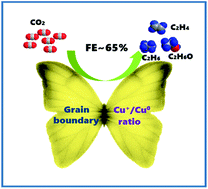A strategy to control the grain boundary density and Cu+/Cu0 ratio of Cu-based catalysts for efficient electroreduction of CO2 to C2 products†
Abstract
Cu(OH)2/CuO nanocomposite-derived Cu2O/Cu was highly efficient for CO2 electroreduction to C2 products. The highest faradaic efficiency and current density could reach 64.5% and 26.2 mA cm−2, respectively. By changing the calcination time, moderate grain boundary density and the Cu+/Cu0 ratio in catalysts can be controlled, leading to a large number of active sites and low interfacial charge transfer resistance.



 Please wait while we load your content...
Please wait while we load your content...